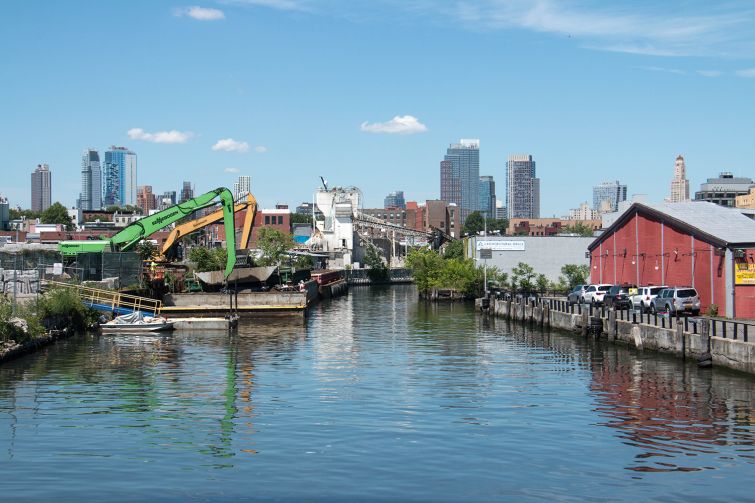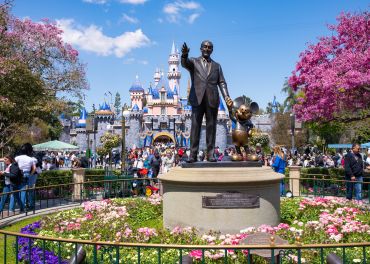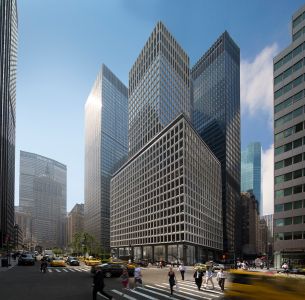Gowanus Tiptoes Toward a Long-Planned Rezoning
By Rebecca Baird-Remba June 27, 2018 10:30 am
reprints
Gowanus is one of the last industrial outposts in gentrifying Brooklyn. Much like East Williamsburg and Bushwick, the streets of Gowanus feature artist studios interspersed with trendy bars and concrete factories as 18-wheeled trucks trundle past.
But the increasingly expensive neighborhood, which is cut in half by the heavily polluted Gowanus Canal, is finally primed for a major change: a city-initiated rezoning. The long-planned land use endeavor will rezone a few dozen blocks around the manmade waterway, in an effort to encourage new residential development with affordable housing, new midrise commercial projects and infrastructure improvements throughout the neighborhood.
After five years of meetings hosted by the local councilman and city planners, the Department of City Planning earlier this month released a tentative land use framework that sketched out the basics of the rezoning and its goals. The highlights include rezoning several of the industrial blocks around the canal to make way apartment buildings that could range anywhere from six to 22 stories, and upping the zoning along Fourth Avenue to allow 12- to 17-story residential developments. As with all of the city’s rezonings, new residential developments will be subject to mandatory inclusionary housing, which requires builders to set aside 25 to 30 percent of their apartments as affordable housing. And on the blocks where only low-density manufacturing is allowed today, the city will incentivize the construction of new mid-rise office and industrial buildings.
The 118-page document also presents a lengthy list of neighborhood benefits that the city is expected to fund, including $34 million in sewer and storm drain improvements in Gowanus’ Industrial Business Zone (which is not being rezoned), new affordable artist housing, repairs for the three large public housing developments in the area, new public spaces and infrastructure upgrades. The city and the federal Environmental Protection Agency also have to wrangle 25 different “responsible parties”—including National Grid—to pay for the cleanup of the Gowanus Canal, which is expected to cost several hundred million dollars.
The promise of repairs for three dilapidated New York City Housing Authority projects—Wyckoff Gardens, Gowanus Houses and Warren Street Houses—is encouraging to community groups. But they are pushing for the city to set aside a specific amount of funding before the rezoning begins, rather than leaving NYCHA tenants hanging until the public review process is underway.
“The city is at least indicating that it’s looking to consider investments in NYCHA and consider more tools in the IBZ,” said Christopher Walters, the rezoning technical assistance coordinator for the nonprofit Association for Neighborhood Housing and Development. “We’d be looking for a firm commitment on targeted investment in those local campuses as the rezoning moves forward.”
Developers, neighbors and local activists are thrilled to see the rezoning finally advancing. The reasoning for the move was clear-cut: Gowanus had spent years stuck in limbo, with its industrial users slowly departing for cheaper parts of the outer boroughs or leaving the city entirely. Meanwhile, the neighborhoods surrounding it became some of the most expensive in the city. Neighbors had complained for years of sewage backing up into their sinks when it rained, and the canal, designated a national Superfund site in 2010, was both a serious pollution hazard and a stinky nuisance.
But at the same time, the plan is not a formal zoning document. It doesn’t include specific estimates about how many apartments will be built, and it doesn’t detail what the actual zoning will be—which is arguably the most important facet of any land use proposal for both activists and developers. The city expects to release a draft zoning proposal this winter, according to the timeline in the document. The rezoning would enter public review sometime next year.
Some local landlords are frustrated that the city seems to be dragging its feet on the actual rezoning process.
“There are a couple real challenges to the process they’ve set forth,” said one major Gowanus property owner, who requested anonymity to avoid alienating city officials. “There are no details, and when the details do become available, a lot of people will be unhappy with it. If you’re a landowner and you bought a site thinking you were going to build residential there, and city planning and the community have a different idea for you, that’s going to make a big difference and you’re going to raise hell. But if you’re an area resident and you like your 360-degree view, you’re going to raise hell, too.”
The owner added that the ambiguity of the newly released framework raised questions about whether the rezoning would pass before Mayor Bill de Blasio and the area’s current councilman, Brad Lander, leave office.
“The time frame makes me nervous that it’s not going to get done under this administration and this council member,” the landlord said. “It seems crazy to think that in three years it won’t get done, but given other rezonings and how long they’ve taken…”
When the planning framework was released on June 5, Lander released a joint statement with Councilman Stephen Levin, who represents the northern edge of Gowanus. The aims of the rezoning, they said, include “investments in sustainability, resiliency, flood-proofing, transportation and educational infrastructure; creating affordable and mixed-income housing, and preserving and strengthening NYCHA; and strengthening the ‘Gowanus mix’ of manufacturing, artists and cultural organizations, creative businesses, historic buildings, and not-for-profits.”
A few large parcels in Gowanus traded hands in the months leading up to the release of the framework, and real estate watchers began to speculate that the sales were linked to the rezoning. In one instance, Two Trees Management Company spent $115 million acquiring two large, adjacent industrial properties at 1-37 12th Street and 118 Second Avenue. The combined 15-acre site sits within the Industrial Business Zone, and a Two Trees spokesman said the company had no plans to develop or rezone the parcel in the near future.
“We have income-producing tenants and we’re not in any rush to change the use,” the Two Trees spokesman, David Lombino, said. “But it certainly is a long-term development opportunity.”
The Dumbo, Brooklyn-based developer also owns an industrially zoned parcel at 424 Hoyt Street between Fourth and Fifth Avenues. The property, which is currently home to a parking lot and a small warehouse, will benefit from a commercial upzoning if the current proposal becomes a reality. Two Trees hopes to develop the lot into a mid-rise office building with a school, Lombino said.
In addition, Two Trees is co-developing one of the neighborhood’s largest publicly owned projects. In January, the city announced that Two Trees and Arker Companies would build two 16-story buildings with 500 apartments—half of which are slated to be affordable housing—on a parking lot at NYCHA’s Wyckoff Gardens. The pair will pay NYCHA $37 million, with $18.5 million set to go toward repairs for the public housing project, the New York Daily News reported.
Domain Companies also recently picked up two parcels along the canal, paying $47.5 million for 420 Carroll Street and $26.5 million for 545 Sackett Street. Both are currently zoned for heavy manufacturing, but if the rezoning goes through, the Carroll Street parcel could be developed with an eight- or 10-story apartment building.
Domain and other developers in the area will be expected to work with the city to upgrade Gowanus’ aging sewers and help build a public esplanade along the canal. Owners of canal-side properties will likely follow the blueprint created by Lightstone, which developed a two-building residential project at 363-365 Bond Street in 2016. The firm undertook a contentious rezoning process several years ago and agreed to build affordable housing and public green space and perform infrastructure upgrades. It elevated its properties above the 100-year flood plain, built new separate sewer systems for Bond, 1st and 2nd Streets, created bioswales and a rain garden, and developed a small stretch of public waterfront with seating and plants designed to help with rainwater absorption. All told, Lightstone built 700 apartments, 140 of which were affordable. It also developed retail and community spaces, one of which is occupied by the Gowanus Dredgers, a boat club that allows members and the public to canoe up and down the canal.
Scott Avram, a senior vice president for development at Lightstone, believes that other local developers will be willing to spend tens of millions of dollars on sewers and public open space because it’s in their best interests.
“As far as creating the green space and infrastructure upgrades, I think those are easy things that developers will want to do,” he said. “It is expensive, but on the other hand there’s a tangible benefit to the developer, the constituents and the neighborhood. A cleaner, better canal, a reduction in CSO [combined sewer overflow] events. I think there’s a uniform acceptance that there’s a good reason to do all these things.”
While Avram said that Lightstone was “beyond excited” about the rezoning, brokers offered mixed predictions of how it would affect the neighborhood. Many speculated that there would be few, if any, sales in the area until the rezoning had entered public review.
“I would argue that between now and when the specifics of the rezoning are announced, you’re going to see very little activity in this market,” said Dan Marks, a partner at Prospect Heights, Brooklyn-based TerraCRG . “Before people were getting frustrated, and they said I’m tired of waiting for this. Now the rezoning is within our grasp. What we don’t need to happen is any further delay in the specifics coming out, which will keep this market in a state of limbo.”
Marks also expects to see new commercial development on the upzoned manufacturing parcels, as long as the city follows through on its promise to loosen parking requirements for industrial and office projects in the neighborhood.
“There’s a tremendous amount of unused air rights in the IBZ that continue to go unused because the parking requirements are too high, and there’s nowhere to put the parking,” he explained. “It’s too expensive [to build parking]. There is a demand for more commercial space, but it’s just not marketable right now. You’re being left out of the residential part of the rezoning but you’re going to be able to buy unused air rights and add [floor area ratio] to your property. Shrinking or eliminating parking requirements for your property makes it much more marketable.”
On the other hand, Sean Kelly, an investment sales broker at outer-boroughs-focused Ariel Property Advisors, felt that new construction office space in the area wouldn’t pencil out.
“Here’s the challenge with building office space: a lot of times the revenue generated by that project isn’t supported by pricing,” Kelly said. “Frankly with the amount of commercial coming online in Brooklyn, I don’t see the land values for commercial increasing.”
Matthew Rosenzweig, a broker in Marcus & Millichap’s Brooklyn office, pointed out that real estate watchers are always somewhat skeptical about new office development in a somewhat untested market.
“I’ve been around long enough to remember the discussions about Hudson Yards and the rebuilding of the World Trade Center and the questions of ‘Will the lenders be in place?’ and ‘Will the rents 3justify the cost of construction?’ ” he said. “And it always happens. The fundamentals around Gowanus are stronger than East Williamsburg, and I don’t see it as that big of a question mark.”


